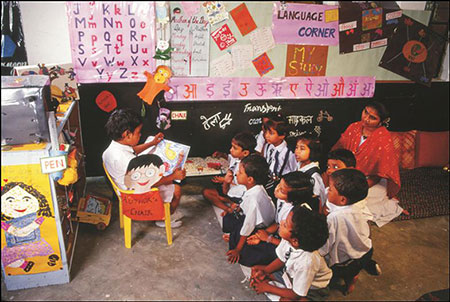3 The students’ reading
Now try the following activities.
Activity 3: Talk to your students about reading
First, do Activity 2 and make a list of books or other reading materials that you could collect in order to start a class ‘mini-library’.
In the lesson, tell your students that you want to make a book area in the classroom. Write the following questions on the board:
- What books have you read?
- Which ones did you like, and why?
- What kinds of book would you like to read?
- Are there other things you would like to read, maybe on a computer?
Divide the students into pairs and get them to ask each other the questions that you have written on the board. Give them a few minutes to do this and then bring the class back together. Ask for their answers to the questions and write their ideas on the board.
After the lesson, consolidate their ideas. Compare their ideas to your own list. Do their ideas match yours?
What did you find out?
How can this kind of information help you tailor the support you can give to individual students as readers?
Over the next few weeks, assemble your small selection of reading materials.
Will you have rules for the ‘library’? Will you tell parents about the library? Could you ask them to help? Perhaps you could ask your students to plan a small ceremony for the opening of your book area.
You can use a reading corner in a variety of ways. By choosing a range of reading materials you can cater to diverse tastes and needs of students. For example, a gifted student may find it interesting to read challenging texts that she otherwise may not have access to. Similarly, being able to read texts suited to their reading levels will build up the confidence of students who have reading problems. With the help of colleagues and older students you could also prepare worksheets to supplement their reading.
A reading corner will also help you with classroom management. If you have a large class or teach a multigrade class, one group can be assigned independent reading at the corner while you work with others, and vice versa. Of course it will take some time for students to work independently in a disciplined manner if they are not used to it. But with firm rules and initial guidance, they can be taught to do so.
Video: Involving all |
The next activity is about reading aloud.
You will know how much students love to imitate their teacher. What you do and say, they will do and say. When you read aloud, you are a model for the enjoyment of reading. Reading aloud, and having students read aloud, will help you and your students improve your pronunciation of English.
Activity 4: Reading aloud with expression
Choose a short story or a poem in English that you know well and that you think your students will enjoy. It does not need to be from the textbook. Read the story or the poem aloud to the class.
Then invite a student to read the story to the rest of the class (Figure 3). Let the student hold the book and pretend to be the teacher. The student may have memorised some or all of the text, but this is fine – let the student imitate the way you read with expression and enthusiasm. Sit with the other students and show them how to be a good listener. Join in if there are choral parts to the reading.
Figure 3 A student reads a story to other students and the teacher.
You must avoid attaching any language drills to this reading aloud activity. Simply focus on the pleasure and enjoyment of reading.
When you let students read aloud to the class, with you in the audience, you can observe reading skills and behaviours. Do students handle books carefully? Are they reading or repeating from memory, or a bit of both? Are the other students listening and responding?
2 Making a book area

